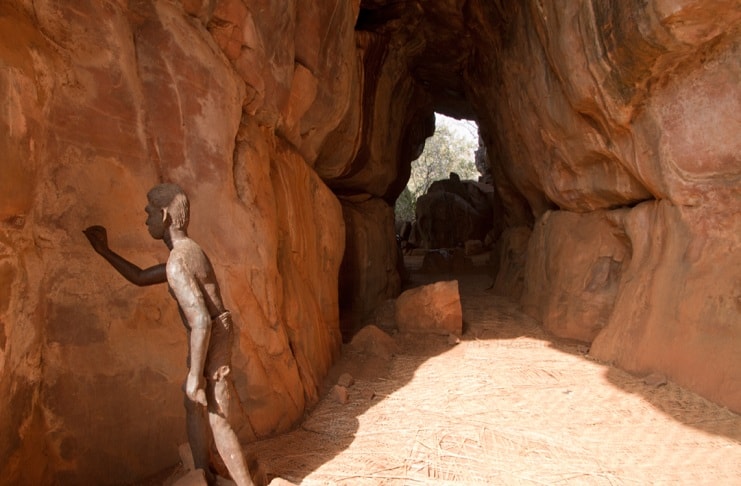There are a few tourist destinations that offer a trip down the history with a slice of natural beauty. Bhimbetka, a natural art gallery and an architectural treasure in Madhya Pradesh is one such destination. With more than 500 rock shelters, Bhimbetka is a true representation of immense awe and wonder in the soul of every visitor. The term Bhimbetka is drawn from the word Bhim ka Bethika, the place where Bhim had sat and deeply performed his meditation.
Discovered during a train ride by an archaeologist Dr. Vishnu Shridhar Wakankar in 1957-58, these ancient caves take you on a journey through the historical period. Surrounded in natural beauty, Bhimbetka caves have been listed under the UNESCO World Heritage site.
The Attractions of Cave Paintings

Most of the paintings listed below are drawn in the simple colours of red and white with randomly occasional dashes of yellow and green colour, with themes culled from activities in everyday existence, a large number of a long time ago. The scenes depicted are mainly of dancing, enjoying music, hunting, horse riding, elephant riding, decorating bodies, and gathering honey. Household scenes as well constitute an occasional theme. Animals including tigers, lions, wild boar, bisons, elephants, dogs and crocodiles – species that pre-historic guy must have encountered – are already also portrayed. These shelter walls are also designed with religious symbols that were preferred with these pre-historic artists. The paintings are often superimposed, which reveals the surface was used by unique people at unique times. A few of the work is as old as 30,000 years, although the extra recent pictures may be traced back again towards the medieval time period.
Actually, the drawings might be categorized underneath 7 distinct intervals. They’re:
Period of time I (Upper Palaeolithic)
They’re linear representations in green and red of massive herds of animals which have long grown to be extinct from these places. For instance, rhinos, wild buffaloes, bisons and mammoths proven in the cave paintings of Bhimbetka might be traced again towards the Palaeolithic age when these creatures were extant.
Some of the paintings also depict mythical creatures and activities. These specimens, some of them nearly 13,000 years outdated, show excellent vitality and narrative skill. A few of the animals and rituals can’t be connected to any present-day spiritual figure and ceremony. Furthermore, even though the rock art internet site is located inside a tribal region, the tribals refuse to accept any direct or indirect relationship with these paintings.
Period of time II (Mesolithic)
Significantly smaller in size, the stylised figures during this group portray the linear decoration on the body. Along with animals, people also make an appearance in these pictures. Scenes depicting hunters armed with spears and arrows, barbed and tipped with microsites, might be witnessed about the walls. Hunting scenes were a well-liked motif together with the Mesolithic rock painters. Also in evidence are drawings of birds, musical instruments, and of eve Communal dances are also drawn around the partitions, together with photos of domestic bliss, like females and young children performing household chores.
The paintings of the Mesolithic time period have a very deeper significance, and 1 cannot stay immune to the pleasure that gradually builds up as 1 analyses these photos. It can be a moment in time when our ancestors had been taking a leap forward from animal to human existence, groping cautiously to obtain social organization. This was when civilization, as we all know it, very first made its tentative appearance about the craggy hills from the Vindhyas.
Period of time III (Chalcolithic)
An observation in the paintings of this interval reveals a shut affinity with the paintings performed on Chalcolithic pottery. This is what led archaeologists to the conclusion that Chalcolithic tribes had been related to the Bhimbetka rock shelters. The paintings reveal that during the Chalcolithic period, the cave dwellers of Bhimbetka had met the agricultural communities on the Malwa plains, and started a program of barter to fulfill their needs. The cave dwellers almost certainly exchanged Chalcolithic pottery with jungle commodities. Chalcolithic artwork at Bhimbetka is quite similar to Chalcolithic drawings found on pottery, in Malwa. The paintings, mainly in red and white, are quite similar towards the ones discovered across the same time in Iran, Iraq, Italy and Scandinavia. In the course of this interval, the cave dwellers were greatly influenced by pottery styles and adopted geometrical patterns to fill the cavity of physique mass in the paintings drawn by them.
A couple of a long time ago, a theory did the rounds that Chalcolithic guy only painted in these rock shelters but by no means dwelled in them. But which has been exploded by historians who found as quite a few as 13 burials at Bhimbetka, and C-14 or carbon dating techniques trace the burnt bones towards the Chalcolithic age.
Period IV & V (Early Historic)
The geometrical patterns on the Chalcolithic age were adopted by early historical painters as effectively, but they introduced new symbols which are also discovered on early historic coins of India. Painted primarily in red, white and yellow, the figures of riders, spiritual symbols, tunic-like dresses and scripts of this group follow a decorative and schematic style. Spiritual beliefs are represented by tree gods, Yakshas (tree spirits) and sky chariots.
Period VI & VII (Medieval)
The paintings of this era were mostly green in colour. Occasionally, pale yellow, dark purple and shades of red had been also used, and the drawings of human figures differ from individuals of your earlier five periods. The paintings display a certain crudeness and degeneration in their artistic style, leading one towards the conclusion that rock art at Bhimbetka was already past its zenith as we entered the medieval time period. The photos related to the medieval period of time are fairly simplistic and have none with the intricate styles on the Mesolithic or Early Historical tradition. The colours employed by the cave dwellers were prepared by combining manganese, red stone and wooden coal. Occasionally, the extracts of leaves and the fat of animals were also employed inside the mixture. Even after so quite a few centuries have elapsed, the colours are still discernable, thanks towards the chemical reaction resulting from the oxides current on the floor in the rocks.
By studying far more than 760 painted rock shelters at Bhimbetka, we can make a tentative estimate of their date. However, this piece is obviously not the last word on Bhimbetka rock art and does not purport to be so. Future discoveries applying modern methodology may perhaps well force archaeologists to alter their analysis and modify the chronology with the paintings. Nevertheless, one thing is for certain – the photos are important not just from the point of view of artistic merit; they trace the evolution of civilization in these parts from pre-history up to the beginning of your modern era.

 Call
Call WhatsApp
WhatsApp Enquiry
Enquiry